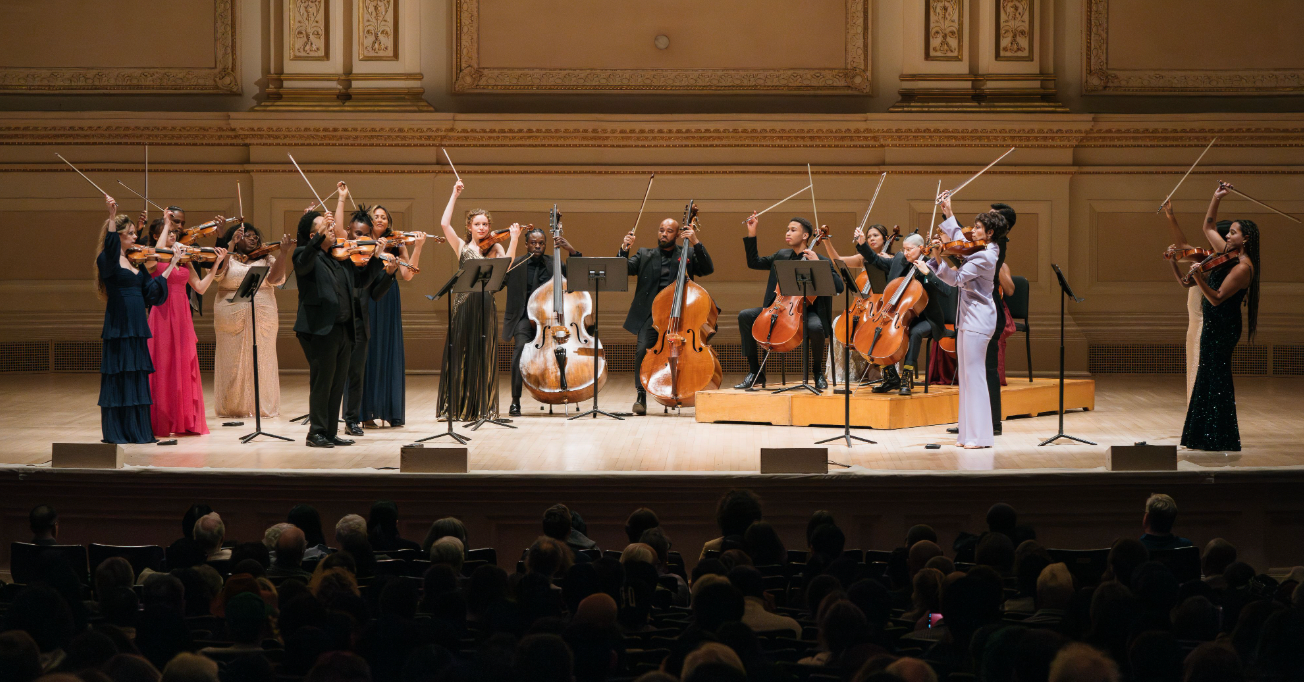All material found in the Press Releases section is provided by parties entirely independent of Musical America, which is not responsible for content.
Press Releases
Carnegie Hall Presents the Sphinx Virtuosi in Visions of Peace – October 17, 2025
 FOR IMMEDIATE RELEASE
FOR IMMEDIATE RELEASE
Contact: Katy Salomon | Primo Artists | VP, Public Relations
katy@primoartists.com | 646.801.9406
Contact: Saratoga Schaefer | Primo Artists | Publicist
saratoga@primoartists.com | 646.470.4456
Carnegie Hall Presents the Sphinx Virtuosi
in Visions of Peace – October 17, 2025
Visions of Peace Imagines a World Where Music Serves as an Emissary of Reconciliation and Unity, Highlighting Works By Contemporary Composers
Including the New York Premieres of Quenton Blache’s Visions of Peace, Co-Commissioned by Carnegie Hall and New World Symphony, and William Grant Still’s Suite for Violin and Orchestra, Arranged by Randall Goosby

“Sphinx’s steady, patient work has come to seem prescient.” – The New York Times
“...the Sphinx way was to play with a fire lit under every phrase.” – The Boston Globe
New York, NY (September 11, 2025) – The self-conducted string orchestra Sphinx Virtuosi — described as "top-notch...more essential at this moment than ever" (The New York Times) and having "immeasurable power, unwavering command, and soulful beauty" (The Washington Post) — returns to Carnegie Hall's Stern Auditorium / Perelman Stage on October 17, 2025 at 7:00 PM for Visions of Peace. The concert includes the New York premiere of Quenton Blache’s Visions of Peace, co-commissioned by Carnegie Hall and New World Symphony, and William Grant Still’s Suite for Violin or Cello and String Orchestra, arranged by violinist Randall Goosby and co-commissioned by New World Symphony. The concert also includes composer Clarice Assad’s Perpetual Motion; José White Lafitte’s La Bella Cubana; Sergei Prokofiev’s Piano Sonata No. 7 in B-flat Major, Op. 83 Stalingrad, arranged for string orchestra by Rubén Rengel; and Alberto Ginastera’s Concerto For Strings, Op. 33 IV. Finale. Visions of Peace imagines a world where music serves as an emissary of reconciliation and unity, a collection of new and familiar voices that transcends borders in a jubilant celebration of the human spirit.
Clarice Assad’s Perpetual Motion, the fourth movement of her Impressions: Suite for Chamber Orchestra, is a celebration of vibrancy in sound, color, and spirit. On our journey toward peace, moving forward together as one, this music resonates with the constant resolve that this suite showcases in sound and form. Assad's intention was not merely to compose music but to create a vivid musical portrait celebrating the individuality, spirit, and unique flair of each musician within the New Century Chamber Orchestra, for whom this work was originally commissioned. The music reflects their first interactions with the composer herself. The composer integrates lively Brazilian rhythms — hints of choro, samba, and salon dances—within a string ensemble context, merging classical textures with the rhythmic vitality of her homeland. The Sphinx Virtuosi spent time in Brazil in 2022 and came away deeply inspired by the country’s music and people. This choice is, in part, an homage, as well as a celebration of the work itself.
Writing primarily for his own instrument, violinist Joseph (José) White Lafitte wrote La Bella Cubana, a habanera for two violins, in addition to numerous etudes and a virtuosic violin concerto. In this string orchestra arrangement by Robert Debbaut, the melodic solos are spread throughout the orchestra while traditional Cuban dance rhythms in the contrasting middle theme capture the vibrant joy of the original work.
In this performance, violinist and arranger Rubén Rengel—a member of the Sphinx Organization’s extended family of artists—reimagines Prokofiev’s Piano Sonata No. 7 in B-flat Major, Op. 83 “Stalingrad” for an 18-member, self-conducted string orchestra. This piece invites listeners to confront a paradox: how a work born of destruction and conflict can, decades later, serve as a reminder of resilience, solidarity, and the enduring human longing for peace. Prokofiev’s Seventh Sonata does not offer easy comfort—instead, it challenges us to listen to the sounds of war and imagine, all the more vividly, the peace that must follow.
Confucius’s counsel to “Study the past if you would define the future” anchors the profound duality that pillars Quenton Blache’s Visions of Peace. The journey begins through a solitary voice’s contemplation of our shared history, entreating us to reflect as the sage did millennia ago. Its melodious question ripples through the ensemble, burgeoning, until a hymn-like prayer, the heart of the work, comes forth. This anthem for a better world is heralded by serene harmonic slides in the double basses, hope and spirit made into sound. In accelerating bursts of vitality, Baroque-era motifs echo our past and oppose the lush, modal harmony of the prayer. This duality crests as the call is answered: a vision of peace materializes, utopian and exaltant. As Blache reflects that peace is more mosaic than clear glass, the epilogue offers wishes of solace, and a final “amen” rings.
Arranged by violinist Randall Goosby, William Grant Still’s Suite for Violin or Cello and String Orchestra is a powerful testament to the richness, resilience, and unwavering spirit of Black culture. Each movement was inspired by a sculpture created during the Harlem Renaissance, and each one depicts a unique facet of the Black experience. The first movement is inspired by Richmond Barthé’s sculpture, African Dancer, through which Barthé aimed to portray the spirituality of his people. The second movement, Mother and Child, is the heart and soul of this piece and is inspired by the work of Sargent Johnson. The final movement is derived from Augusta Savage’s sculpture, Gamin, depicting a mischievous young boy (specifically, Savage’s nephew, Ellis Ford) roaming the streets of Harlem. “There is so much joy and humour in this music, and I wanted to reflect that in the orchestra part,” Goosby says. “You will hear pops of pizzicato throughout the ensemble, as well as some jabs of call and response between the solo part and principal players that I hope will leave a smile on your face!”
The final piece in the Visions of Peace program is Alberto Ginastera’s Concerto for Strings, Op. 33 IV. Finale. Ginastera, widely considered to be Argentina’s most revered classical composer, was deeply involved in promoting and developing his nation’s musical life. Among Ginastera’s most important chamber works is his String Quartet No. 2, composed in 1958. In 1965, Ginastera orchestrated the quartet into the virtuosic Concerto per Corde, Op. 33 (“Concerto for Strings”), premiered the following year by the Philadelphia Orchestra. The Finale Furioso featured in this concert is a relentless, fierce movement of perpetual motion, blazing with rhythmic verve and masterfully crafted for the string instruments that drive its obsessive, wild dance.
Program
Friday, October 17, 2025 at 7:00 PM
Carnegie Hall Presents Sphinx Virtuosi: Visions of Peace
Carnegie Hall Stern Auditorium / Perelman Stage | New York, NY
Link: www.carnegiehall.org/Calendar/2025/10/17/Sphinx-Virtuosi-0700PM
Program:
Clarice Assad – Perpetual Motion
José White Lafitte – La Bella Cubana
Sergei Prokofiev: Piano Sonata No. 7 in B-flat Major, Op. 83 Stalingrad, Mvt 3: Precipitato [Arranged for string orchestra by Rubén Rengel]
Quenton Blache – Visions of Peace [NY Premiere; co-commissioned by Carnegie Hall and New World Symphony]
William Grant Still – Suite for Violin and Orchestra [arr. for cello and orchestra by Randall Goosby] [NY Premiere, Commissioned with a gift from the Keith and Renata Ward Emerging Composer Fund]
Alberto Ginastera – Concerto For Strings, Op. 33 IV. Finale
Sphinx Virtuosi
Sterling Elliott, cello
About Sphinx Virtuosi
Sphinx Virtuosi is a dynamic, self-conducted chamber orchestra and the flagship performing ensemble of the Sphinx Organization, the nation’s leading nonprofit dedicated to transforming the arts. Comprising 18 of the nation’s most accomplished professional string players, Sphinx Virtuosi is redefining classical music through artistic excellence, pioneering programming, and cultural leadership.
Recognized for their artistry and commanding presence, Sphinx Virtuosi has been praised by The New York Times as “top-notch... more essential at this moment than ever.” The Strad lauds their “elegant ascent into the upper ranks of string orchestras,” a testament to their growing influence in the field. With performances that captivate audiences nationwide, their annual Carnegie Hall appearance has become a celebrated highlight of the fall season. Their critically acclaimed debut album, Songs for Our Times (Deutsche Grammophon) was hailed as “a knockout” by Gramophone, which praised their “consistently polished and passionate performances.”
Members of Sphinx Virtuosi are sought-after soloists, chamber musicians, and faculty members at top institutions. They have performed with major American orchestras, including the New York Philharmonic, Cleveland Orchestra, and the Philadelphia, Detroit, Atlanta, Seattle, and Pittsburgh Symphony Orchestras. Beyond the concert stage, they are artist-citizens, leading impactful community initiatives and fostering deep engagement with audiences worldwide.
Sphinx Virtuosi has collaborated with legendary artists such as Terence Blanchard, Denyce Graves, Sweet Honey in the Rock, Damien Sneed, Will Liverman, J’Nai Bridges, Abel Selaocoe, and Davóne Tines. Members of Sphinx Virtuosi have also worked with cultural icons like Beyoncé and Jay-Z, with high-profile appearances on The Tonight Show Starring Jimmy Fallon and the GRAMMY Awards.
Sphinx Virtuosi Tours are made possible through the support of Robert F. Smith, JPMorgan Chase, and National Endowment for the Arts. Learn more at www.SphinxMusic.org/sphinx-virtuosi.
About Sphinx Organization
The Sphinx Organization is dedicated to transforming lives through the power of the arts and has reached more than 100 million people worldwide.
Focused on increasing representation in classical music and celebrating excellence, Sphinx programs serve beginner students, seasoned classical music professionals, cultural entrepreneurs, and artistic administrators by addressing the systemic lack of access within Black and Latino communities.
Based in Detroit, Michigan, with global reach, Sphinx envisions a day where every young person has the opportunity to express themselves and learn classical music, where audiences reflect the people we see on our streets, and where leadership – on stage and off – includes all deserving voices. We are working toward a future in which our art form reflects our greater society. Learn more at www.SphinxMusic.org.
*Photo Credit: Brian Hatton
# # #





 FEATURED JOBS
FEATURED JOBS

 RENT A PHOTO
RENT A PHOTO


